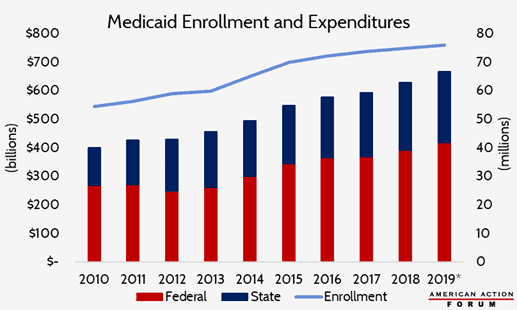Weekly Checkup
October 12, 2018
Medicaid Growth, Past and Future
The Medicaid actuaries recently released their annual status update on the program. The top-line numbers reveal no surprises: Expenditures and enrollment continued to rise, with total outlays in FY2017 estimated to have increased to $592.2 billion, up 2.6 percent from the year prior. Enrollment grew at a slightly slower pace of 2.1 percent, reaching 73.8 million beneficiaries. Federal expenditures held steady as a share of overall spending at 63 percent, where it’s been since 2015 following the Medicaid eligibility expansion.
When you look at the trends since 2010, however, more interesting data points are revealed. Total expenditures have increased an estimated 57 percent since 2010, and by next year it is estimated expenditures will be 66 percent higher than they were at the start of the decade. What may be the biggest surprise to some, though, is that state expenditures since 2010 have increased much more rapidly than federal expenditures: 79 percent versus 46 percent. Next year, those percentages are expected to reach 88 percent and 56 percent, respectively. So much attention has been paid over the past several years to the Medicaid expansion—which has been almost completely financed by the federal government—that some may have expected federal expenditures to have grown much more quickly than state expenditures. Yet the expansion population still represents only 16.5 percent of Medicaid enrollees.
Breaking down the data even further shows that states’ primary cost growth is due to increased benefit expenditures, whereas the federal government has seen dramatic increases in administrative expenses. The states’ benefit expenditures have increased 83 percent since 2010 while their administrative expenditures have only increased 27 percent. The federal government, on the other hand, is now spending 88 percent more on administrative expenses in Medicaid but only 44 percent more directly on benefits.
Also surprising is how much expenditures have increased given that enrollment has increased only 37 percent. I say “only” 37 percent because it is dramatically less than the expenditure growth of 57 percent, but 37 percent enrollment growth in 8 years is quite significant. What this disconnect really shows is a more startling reality: Expenditures are rising much more quickly than enrollment, which really becomes apparent when both are put on the same scale, as shown in the chart below. Put more simply, the cost per enrollee is rising substantially each year. In fact, the average cost per Medicaid enrollee has risen 14.2 percent since 2010, from $7,367 to $8,413; by next year, it is expected the nine-year growth rate will be 19.2 percent.
These figures will obviously continue to climb going forward. While the 2.6 percent expenditure growth rate in 2017 was much slower than the 5.1 percent growth rate seen in 2016, the growth rate is projected to pick right back up next year. Enrollment will continue to climb, particularly among the elderly as a result of the Baby Boomers reaching retirement, and since the elderly typically require more care, spending per person will likely increase more quickly. Expenditures are expected to grow at an average annual rate of 5.7 percent between 2017 and 2026, at which time total Medicaid expenditures will surpass $1 trillion.
Worth a Look
Modern Healthcare: States call on hospitals to disclose 340B discount use
Wall Street Journal: The Bond Between an African Caregiver and Her New Jersey ‘Mum’
Axios: Trump’s health secretary promises “more to come” on drug prices












